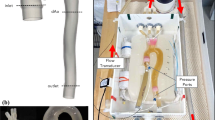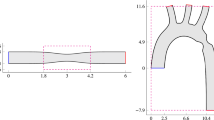Abstract
Recent studies have demonstrated the ability of magnetic resonance imaging (MRI) to provide anatomically realistic boundary conditions for computational fluid dynamics (CFD) simulations of arterial hemodynamics. To date, however, little is known about the overall reproducibility of such image-based CFD techniques. Towards this end we used serial black blood and cine phase contrast MRI to reconstruct CFD models of the carotid bifurcations of three subjects with early atherosclerosis, each imaged three times at weekly intervals. The lumen geometry was found to be precise on average to within 0.15 mm or 5%, while measured flow and heart rates varied by less than 10%. Spatial patterns of a variety of wall shear stress (WSS) indices were largely preserved among the three repeat models. Time-averaged WSS was reproduced best, on average to within 5 dyn/cm2 or 37%, followed by WSS spatial gradients, angle gradients, and oscillatory shear index. The intrasubject flow rate variations were found to contribute little to the overall WSS variability. Instead, reproducibility was determined largely by the precision of the lumen boundary extraction from the individual MR images, itself shown to be a function of the image quality and proximity to the geometrically complex bifurcation region. © 2003 Biomedical Engineering Society.
PAC2003: 8761Lh, 8757Nk, 8719Hh, 8719Rr, 8719Uv
Similar content being viewed by others
REFERENCES
Ethier, C. R., D. A. Steinman, and M. Ojha. Comparisons between computational hemodynamics, photochromic dye flow visualization and magnetic resonance velocimetry. In: The Haemodynamics of Arterial Organs—Comparison of Computational Predictions with and in Data, edited by X. Y. Xu and M. W. Collins. Southampton: WIT, 1999, pp. 131–183.
Friedman, M. H., C. B. Bargeron, D. D. Duncan, G. M. Hutchins, and F. F. Mark. Effects of arterial compliance and non-Newtonian rheology on correlations between intimal thickness and wall shear. J. Biomech. Eng.114:317–320, 1992.
Gati, J., J. Thomas, D. A. Steinman, and B. K. Rutt. High resolution fast spin echo black-blood imaging of the human carotid artery wall at 4T. Proc. Int. Soc. Magn. Reson. Med. 9. Glasgow, 2001:1964.
Glagov, S., C. Zarins, D. P. Giddens, and D. N. Ku. Hemodynamics and atherosclerosis. Insights and perspectives gained from studies of human arteries. Arch. Pathol. Lab. Med.112:1018–1031, 1988.
He, X., and D. N. Ku. Pulsatile flow in the human left coronary artery bifurcation: Average conditions. J. Biomech. Eng.118:74–82, 1996.
Hyun, S., C. Kleinstreuer, and J. P. Archie, Jr. Computational particle-hemodynamics analysis and geometric reconstruction after carotid endarterectomy. Comput. Biol. Med.31:365–384, 2001.
Imbesi, S. G., and C. W. Kerber. Analysis of slipstream flow in a wide-necked basilar artery aneurysm: Evaluation of potential treatment regimens. AJNR Am. J. Neuroradiol.22:721–724, 2001.
Karner, G., K. Perktold, M. Hofer, and D. Liepsch. Flow characteristics in an anatomically realistic compliant carotid artery bifurcation model. Comput. Methods Biomech. Biomed. Eng.2:171–185, 1999.
Kleinstreuer, C., S. Hyun, J. R. Buchanan, Jr., P. W. Longest, J. P. Archie, Jr., and G. A. Truskey. Hemodynamic parameters and early intimal thickening in branching blood vessels. Crit. Rev. Biomed. Eng.29:1–64, 2001.
Ladak, H. M., J. B. Thomas, J. R. Mitchell, B. K. Rutt, and D. A. Steinman. A semi-automatic technique for measurement of arterial wall from black blood MRI. Med. Phys.28:1098–1107, 2001.
Lieber, B. B., A. P. Stancampiano, and A. K. Wakhloo. Alteration of hemodynamics in aneurysm models by stenting: Influence of stent porosity. Ann. Biomed. Eng.25:460–469, 1997.
Liu, Y., Y. Lai, A. Nagaraj, B. Kane, A. Hamilton, R. Greene, D. D. McPherson, and K. B. Chandran. Pulsatile flow simulation in arterial vascular segments with intravascular ultrasound images. Med. Eng. Phys.23:583–595, 2001.
Malek, A. M., S. L. Alper, and S. Izumo. Hemodynamic shear stress and its role in atherosclerosis. J. Am. Med. Assoc.282:2035–2042, 1999.
Milner, J. S., J. A. Moore, B. K. Rutt, and D. A. Steinman. Hemodynamics of human carotid artery bifurcations: Computational studies with models reconstructed from magnetic resonance imaging of normal subjects. J. Vasc. Surg.28:143–156, 1998.
Minev, P. D., and C. R. Ethier. A characteristic/finite element algorithm for the 3–D Navier–Stokes equations using unstructured grids. Comput. Methods Appl. Mech. Eng.178:39–50, 1999.
Moore, J. A., D. A. Steinman, and C. R. Ethier. Computational blood flow modelling: Errors associated with reconstructing finite element models from magnetic resonance images. J. Biomech.31:179–184, 1998.
Moore, J. A., B. K. Rutt, S. J. Karlik, K. Yin, and C. R. Ethier. Computational blood flow modeling based on measurements. Ann. Biomed. Eng.27: 627–640, 1999.
Moore, J. A., D. A. Steinman, D. W. Holdsworth, and C. R. Ethier. Accuracy of computational hemodynamics in complex arterial geometries reconstructed from magnetic resonance imaging. Ann. Biomed. Eng.27:32–41, 1999.
Moore, J. A., D. A. Steinman, S. Prakash, K. W. Johnston, and C. R. Ethier. A numerical study of blood flow patterns in anatomically realistic and simplified end-to-side anastomoses. J. Biomech. Eng.121:265–272, 1999.
Myers, J. G., J. A. Moore, M. Ojha, K. W. Johnston, and C. R. Ethier. Factors influencing blood flow patterns in the human right coronary artery. Ann. Biomed. Eng.29:109–120, 2001.
Perktold, K., and M. Hofer. Mathematical modelling of flow effects and transport processes in arterial bifurcation models. In: The Haemodynamics of Arterial Organs—Comparison of Computational Predictions with and Data, edited by X. Y. Xu and M. W. Collins. Southampton: WIT, 1999, pp. 43–84.
Perktold, K., A. Leuprecht, M. Prosi, T. Berk, M. Czerny, W. Trubel, and H. Schima. Fluid dynamics, wall mechanics and oxygen transfer in peripheral bypass anastomoses. Ann. Biomed. Eng.30:447–460, 2002.
Steinman, D. A. Image-based computational fluid dynamics modeling in realistic arterial geometries. Ann. Biomed. Eng.30:483–497, 2002.
Steinman, D. A., J. B. Thomas, H. M. Ladak, J. S. Milner, B. K. Rutt, and J. D. Spence. Reconstruction of carotid bifurcation hemodynamics and wall thickness using computational fluid dynamics and MRI. Magn. Reson. Med.47:149–159, 2002.
Taylor, C. A., M. T. Draney, J. P. Ku, D. Parker, B. N. Steele, K. Wang, and C. K. Zarins. Predictive medicine: Computational techniques in therapeutic decision-making. Comput. Aided Surg.4:231–247, 1999.
Thomas, J. B., B. K. Rutt, H. M. Ladak, and D. A. Steinman. Effect of black blood MR image quality on vessel wall segmentation. Magn. Reson. Med.46:299–304, 2001.
Thomas, J. B., J. S. Milner, and D. A. Steinman. On the influence of vessel planarity on local hemodynamics at the human carotid bifurcation. Biorheology39:443–448, 2002.
Yuan, C., E. Lin, J. Millard, and J. N. Hwang. Closed contour edge detection of blood vessel lumen and outer wall boundaries in black-blood MR images. Magn. Reson. Imaging17:257–266, 1999.
Zhao, M., F. T. Charbel, N. Alperin, F. Loth, and M. E. Clark. Improved phase-contrast flow quantification by three-dimensional vessel localization. Magn. Reson. Imaging18:697–706, 2000.
Zhao, S. Z., X. Y. Xu, A. D. Hughes, S. A. Thom, A. V. Stanton, B. Ariff, and Q. Long. Blood flow and vessel mechanics in a physiologically realistic model of a human carotid arterial bifurcation. J. Biomech.33:975–984, 2000.-
Author information
Authors and Affiliations
Rights and permissions
About this article
Cite this article
Thomas, J.B., Milner, J.S., Rutt, B.K. et al. Reproducibility of Image-Based Computational Fluid Dynamics Models of the Human Carotid Bifurcation. Annals of Biomedical Engineering 31, 132–141 (2003). https://doi.org/10.1114/1.1540102
Issue Date:
DOI: https://doi.org/10.1114/1.1540102




